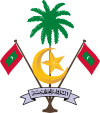|
Administrative divisions of the Maldives

The administrative divisions of the Maldives refers to the various units of government that provide local government services in the Maldives. According to the Decentralization Act 2010, the administrative divisions of the Maldives would consist of atolls, islands, and cities; each is administered by its own local council, under the basic terms of home rule. Geographically, the Maldives are formed by a number of natural atolls plus a few islands and isolated reefs which form a pattern from north to south. Administratively, there are currently 189 islands, 18 atolls and 4 cities in the Maldives. BackgroundDuring the Gayoom presidencyDuring the presidency of Maumoon Abdul Gayyoom, the administrative divisions consisted of 20 administrative atolls, all controlled by the central government in Malé. During the Nasheed presidencySeven provincesIn 2008, in an attempt of decentralization, the Nasheed government divided the country into seven provinces. According to this system, the bill submitted by the government to decentralize the country was passed with the support of opposition-majority parliament, with their amendments to the bill. The final bill passed in 2010 by the parliament and ratified by the president saw the country's decentralisation as 21 constituencies. The seven provinces were the following, followed by the atolls grouped within:
The seven provinces closely correspond to the historic divisions of Uthuru Boduthiladhunmathi. Dhekunu Boduthiladhunmathi, Uthuru Medhu-Raajje, Medhu-Raajje, Dhekunu Medhu-Raajje, Huvadhu (Suvadive, Suvaidu or Suvadiva)[1][2][3][4] and Addumulah. DecentralizationOn 15 October 2010, the government released a finalized list of the administrative constituencies established under the Decentralization Act. It listed 189 administrative constituencies. Out of these constituencies:
Therefore, the final organization of the administrative divisions are as below:
National officesAlthough the earlier provincial decentralization was rejected by Parliament, President Nasheed reinstated the concept through "National Administrations". The National Administrations of Maldives were in the same divisions as the earlier provinces, and the previous province offices were reinstated as the office of that National Administration, to which the atoll councils reported to accordingly. The National Administrations acted as an extension of the central government in Male' for the convenience of dealing with regional affairs. The National Administrations operated under the Ministry of Home Affairs. The seven National Administrations were:-
Each administration was headed by a state minister assigned by the president. All 7 National Offices were abolished by the Waheed administration on 24 April 2012.[5] DivisionsThe first-level divisions are cities and atolls. CityA city is an inhabited area with a population of 10,000+. The criteria also includes a certain level of economic development and facilities available. A city has a "city council" which governs over the affairs of the city, and keeps communication with the central government. A city will not be included within an administrative atoll. A city has further subdivisions called "wards" or "districts". A city council will also govern over any uninhabited islands or resort islands within its designated area. There are four cities in Maldives. They are Malé, Addu, Fuvahmulah and Kulhudhuffushi. AtollThe administrative definition of an "atoll" differs from the actual meaning of the word 'atoll'. While naturally, an "atoll" refers to a ring of islands, an "atoll" in the administrative sense, refers to a group of "island" class constituencies, not necessarily within the requirements of a natural atoll. While the majority of administrative atolls are indeed natural atolls, there are exceptions. Each administrative atoll has an "atoll council" which monitors the work of the "island councils" in the atoll, and keep communications with the central government. An atoll council also governs all uninhabited islands and resort islands in their area. There are 20 atolls in Maldives. IslandThe administrative definition of an "island" differs from the actual meaning of the word 'island'. While naturally, an "island" refers to a land-mass surrounded by water, an "island" in the administrative sense, refers to a specified inhabited area within an administrative atoll, which is governed over by an "island council". While the majority of "island" class constituencies are indeed natural islands. There are 189 such islands, each with its own island council. (Except for Felivaru, Lhaviyani Atoll) Codes and names of the administrative divisionsEvery first-level administrative division of the Maldives have the following:
Each atoll has a capital island. All islands of every atoll have their own official name. All cities have an official name, and names for their subdivisions. They also have a Latin code letter assigned to them. Traditionally, Maldivians call the atolls ending in '-madulu' or '-mathi' by their name without adding the word 'Atoll' at the end. For example, it is correct to write simply Kolhumadulu, without adding the word 'Atholhu' or 'Atoll'. This is also the case in the atoll known as Faadhippolhu as well as the small detached atoll of Fuvahmulah. First-level administrative Divisions of MaldivesAtolls
Cities
See alsoReferences
External links |


